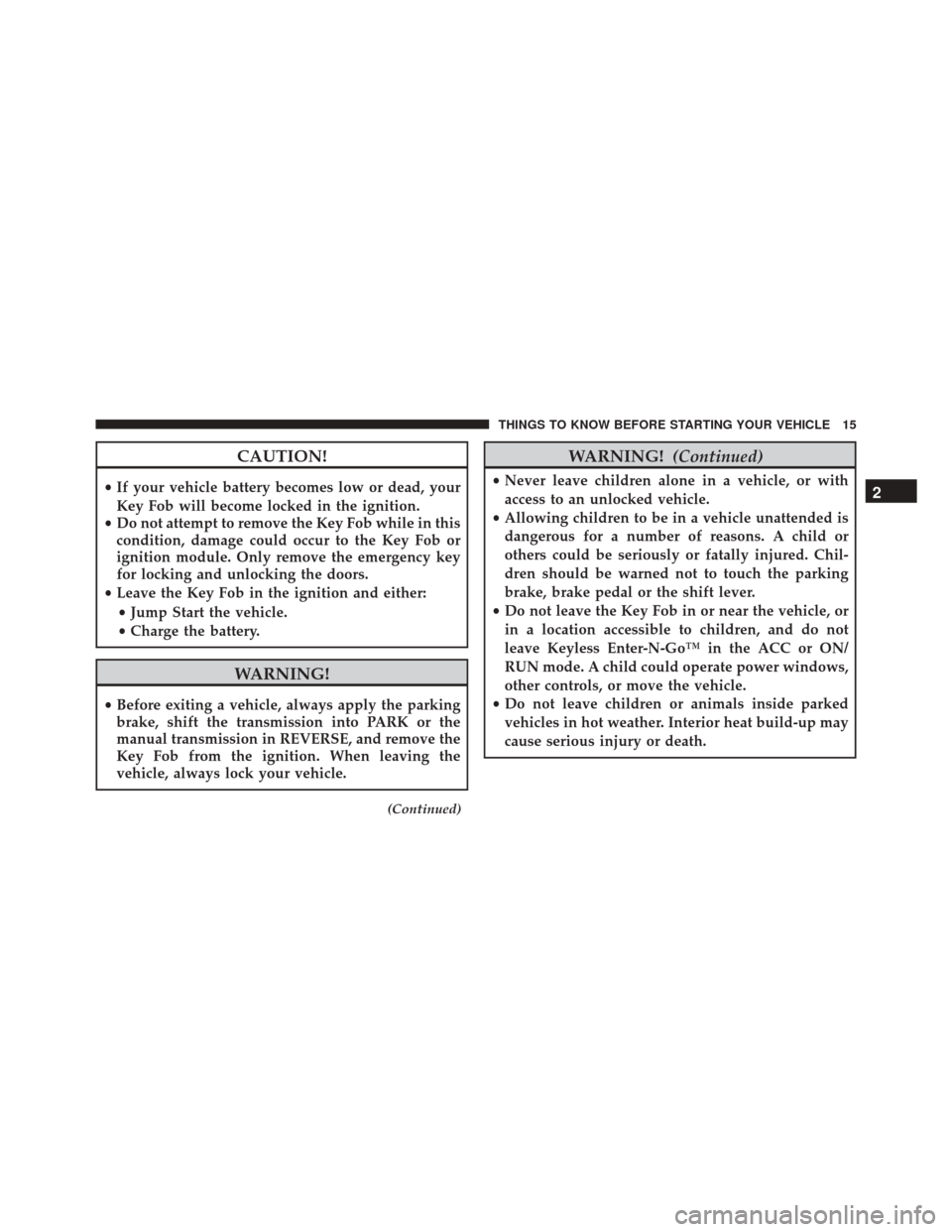Page 12 of 520

▫Programming Additional Transmitters ........27
▫ Transmitter Battery Replacement ...........27
▫ General Information ....................28
�
REMOTE STARTING SYSTEM — IF EQUIPPED . .28
▫ How To Use Remote Start ................29
� DOOR LOCKS .........................32
▫ Manual Door Locks .....................32
▫ Power Door Locks .....................33
� KEYLESS ENTER-N-GO™ — IF EQUIPPED ....36
� WINDOWS ...........................41
▫ Power Windows .......................41
▫ Wind Buffeting .......................43
� TRUNK LOCK AND RELEASE .............43�
TRUNK SAFETY WARNING ................44
▫ Trunk Emergency Release ................45
� OCCUPANT RESTRAINTS ................45
▫ Lap/Shoulder Belts ....................49
▫ Lap/Shoulder Belt Untwisting Procedure .....54
▫ Seat Belts In Passenger Seating Positions ......54
▫ Automatic Locking Retractor Mode (ALR) — If
Equipped ............................55
▫ Energy Management Feature ..............56
▫ Seat Belt Pretensioners ..................56
▫ Enhanced Seat Belt Use Reminder System
(BeltAlert®) ..........................57
▫ Seat Belts And Pregnant Women ...........58
▫ Seat Belt Extender .....................58
10 THINGS TO KNOW BEFORE STARTING YOUR VEHICLE
Page 15 of 520
Key Fob
The Key Fob operates the ignition switch. Insert the
square end of the key fob into the ignition switch located
on the instrument panel and rotate to the desired posi-
tion. It also contains the Remote Keyless Entry (RKE)
transmitter and an emergency key, which stores in the
rear of the Key Fob.
The emergency key allows for entry into the vehicle
should the battery in the vehicle or the Key Fob go dead.
The emergency key is also for locking the glove box. You
can keep the emergency key with you when valet park-
ing.
NOTE:Entering a vehicle using the emergency key with
the theft alarm armed, will result in the alarm sounding.
Insert the Key Fob (even if the Key Fob battery is dead)
into the ignition switch to disarm theft alarm.
Wireless Ignition Node (WIN)
1 — OFF
2 — ACCESSORY (ACCESSORY)
3 — ON/RUN
4 — START
2
THINGS TO KNOW BEFORE STARTING YOUR VEHICLE 13
Page 17 of 520

CAUTION!
•If your vehicle battery becomes low or dead, your
Key Fob will become locked in the ignition.
• Do not attempt to remove the Key Fob while in this
condition, damage could occur to the Key Fob or
ignition module. Only remove the emergency key
for locking and unlocking the doors.
• Leave the Key Fob in the ignition and either:
• Jump Start the vehicle.
• Charge the battery.
WARNING!
•Before exiting a vehicle, always apply the parking
brake, shift the transmission into PARK or the
manual transmission in REVERSE, and remove the
Key Fob from the ignition. When leaving the
vehicle, always lock your vehicle.
(Continued)
WARNING! (Continued)
•Never leave children alone in a vehicle, or with
access to an unlocked vehicle.
• Allowing children to be in a vehicle unattended is
dangerous for a number of reasons. A child or
others could be seriously or fatally injured. Chil-
dren should be warned not to touch the parking
brake, brake pedal or the shift lever.
• Do not leave the Key Fob in or near the vehicle, or
in a location accessible to children, and do not
leave Keyless Enter-N-Go™ in the ACC or ON/
RUN mode. A child could operate power windows,
other controls, or move the vehicle.
• Do not leave children or animals inside parked
vehicles in hot weather. Interior heat build-up may
cause serious injury or death.2
THINGS TO KNOW BEFORE STARTING YOUR VEHICLE 15
Page 23 of 520

•When the Vehicle Security Alarm is armed, the interior
power door lock switches will not unlock the doors.
• The Vehicle Security Alarm is designed to protect your
vehicle; however, you can create conditions where the
system will give you a false alarm. If one of the
previously described arming sequences has occurred,
the Vehicle Security Alarm will arm regardless of
whether you are in the vehicle or not. If you remain in
the vehicle and open a door, the alarm will sound. If
this occurs, disarm the Vehicle Security Alarm.
• If the Vehicle Security Alarm is armed and the battery
becomes disconnected, the Vehicle Security Alarm will
remain armed when the battery is reconnected; the
exterior lights will flash, the horn will sound. If this
occurs, disarm the Vehicle Security Alarm.Tamper Alert
If something has triggered the Vehicle Security Alarm in
your absence, the horn will sound three times and the
exterior lights will blink three times when you disarm the
Vehicle Security Alarm. Check the vehicle for tampering.
Security System Manual Override
The Vehicle Security Alarm will not arm if you lock the
doors using the manual door lock plunger.
ILLUMINATED ENTRY
The courtesy lights will turn on when you use the
Remote Keyless Entry (RKE) transmitter to unlock the
doors or open any door.
2
THINGS TO KNOW BEFORE STARTING YOUR VEHICLE 21
Page 29 of 520

NOTE:
•The interior lights will turn off if you turn the ignition
switch to the ACC or ON/RUN position while the
Panic Alarm is activated. However, the exterior lights
and horn will remain on.
• You may need to be less than 35 ft (11 m) from the
vehicle when using the RKE transmitter to turn off the
Panic Alarm due to the radio frequency noises emitted
by the system.
Programming Additional Transmitters
Programming Key Fobs or RKE transmitters may be
performed at an authorized dealer.
Transmitter Battery Replacement
The recommended replacement battery is CR2032. NOTE:
Perchlorate Material – special handling may
apply. See www.dtsc.ca.gov/hazardouswaste/
perchlorate
1. If the RKE transmitter is equipped with a screw, remove the screw. With the RKE ransmitter buttons
facing down, use a flat blade to pry the two halves of
the RKE transmitter apart. Make sure not to damage
the elastomer seal during removal.
2. Remove and replace the battery. When replacing the battery, match the + sign on the battery to the + sign on
the inside of the battery clip, located on the back cover.
Avoid touching the new battery with your fingers.
Skin oils may cause battery deterioration. If you touch
a battery, clean it with rubbing alcohol.
3. To reassemble the RKE transmitter case, snap the two halves of the case together. Make sure there is an even
2
THINGS TO KNOW BEFORE STARTING YOUR VEHICLE 27
Page 30 of 520

“gap” between the two halves. If equipped, install and
tighten the screw until snug. Test RKE transmitter
operation.
General Information
This device complies with Part 15 of the FCC rules and
RSS 210 of Industry Canada. Operation is subject to the
following conditions:
•This device may not cause harmful interference.
• This device must accept any interference received,
including interference that may cause undesired op-
eration.
NOTE: Changes or modifications not expressly approved
by the party responsible for compliance could void the
user’s authority to operate the equipment. If your RKE transmitter fails to operate from a normal
distance, check for these two conditions:
1. A weak battery in the transmitter. The expected life of
the battery is a minimum of three years.
2. Closeness to a radio transmitter such as a radio station tower, airport transmitter, and some mobile or CB
radios.
REMOTE STARTING SYSTEM — IF EQUIPPED
This system uses the Remote Keyless Entry
(RKE) transmitter to start the engine conve-
niently from outside the vehicle while still
maintaining security. The system has a range of
approximately 300 ft (91 m).
28 THINGS TO KNOW BEFORE STARTING YOUR VEHICLE
Page 31 of 520
NOTE:
•The vehicle must be equipped with an automatic
transmission to be equipped with Remote Start.
• Obstructions between the vehicle and the Key Fob may
reduce this range.
How To Use Remote Start
All of the following conditions must be met before the
engine will remote start:
• Shift lever in PARK
• Doors closed
• Hood closed
• Hazard switch off
• Brake switch inactive (brake pedal not pressed) •
Ignition key removed from ignition switch
• Battery at an acceptable charge level
• RKE PANIC button not pressed
• System not disabled from previous remote start event
• Vehicle theft alarm not active
• Ignition in Off position (Keyless Enter-N-Go™)
WARNING!
•Do not start or run an engine in a closed garage or
confined area. Exhaust gas contains Carbon Mon-
oxide (CO) which is odorless and colorless. Carbon
Monoxide is poisonous and can cause serious in-
jury or death when inhaled.
(Continued)
2
THINGS TO KNOW BEFORE STARTING YOUR VEHICLE 29
Page 42 of 520
Do NOT grab the door handle, when pressing the door
handle lock button. This could unlock the door(s).NOTE:
•
After pressing the door handle LOCK button, you
must wait two seconds before you can lock or unlock
the doors, using either Passive Entry door handle. This
is done to allow you to check if the vehicle is locked by
pulling the door handle, without the vehicle reacting
and unlocking.
• The Passive Entry system will not operate if the RKE
transmitter battery is dead.
The vehicle doors can also be locked by using the RKE
transmitter lock button or the lock button located on the
vehicle’s interior door panel.
Do NOT Grab The handle When Locking
40 THINGS TO KNOW BEFORE STARTING YOUR VEHICLE